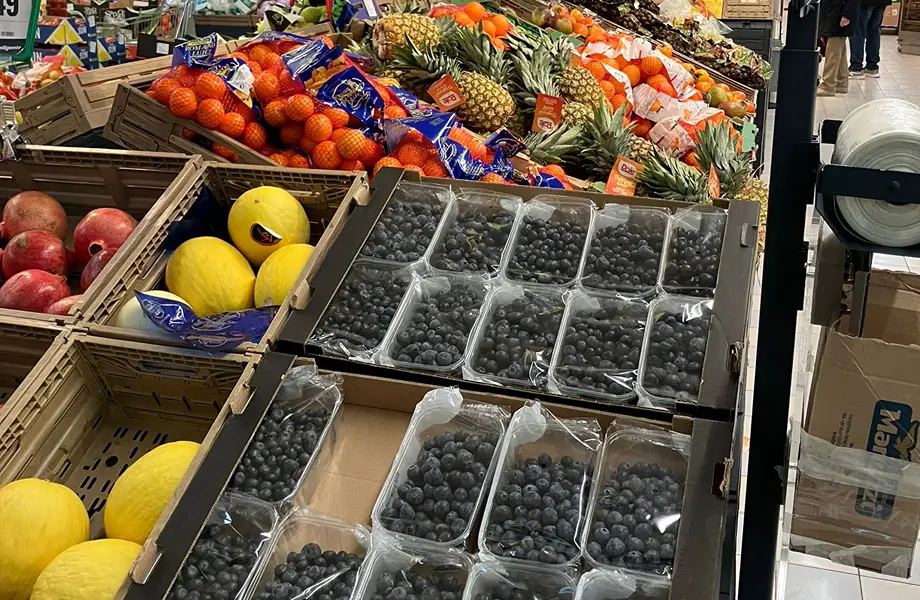In the past, blueberries in Switzerland was gathered from the bushes in the woods, today it is in abundance in the supermarket - all year round.
In June, bright reds begin to fill the baskets: it's strawberry season. Then the raspberry, which needs a little more summer. Later, just as the raspberries and blackberries come to an end, the strawberries are also saying goodbye. Only one berry is not affected by seasonality. It is always there. Round and blue, packed in plastic baskets and snack cups. 365 days a year. blueberry is now in season every day even in Switzerland.
This was not always the case. Twenty years ago, nobody cared about blueberries. People used to pick them in the forest, make compotes out of them or put them in their mouths as soon as they were taken from the bush. Today blueberries are also cultivated in Switzerland. The area under cultivation on Swiss soil has tripled in ten years. It reached 103.6 hectares in 2019, an increase of almost twelve per cent compared to 2018. In 2014, it was 73.4 hectares. A total of 561 tonnes of blueberries were harvested, 52 per cent more than in an average year between 2014 and 2018. Why? Because blueberries are trending and consumption has been increasing for years.
Beat Lehner of Felben-Wellhausen TG is one of the largest producers of blueberries in Switzerland. His bushes grow on nine hectares. In 2015, he entered the business. Because he too saw that it was a boom berry.

Lehner lists other benefits of the berry besides its healthy image: it is easy to eat and store, he says. "You can easily leave blueberries in the fridge for a week - unlike strawberries and raspberries," says Lehner. And what about their taste? "The blueberry doesn't antagonise," says Lehner. It is a fruit with a flavour that many people like, he says. They like them best right off the bush. But with a redcurrant, for example, the tastes would be different.
The flesh is bright, not dark red like that of the wild blueberries that grows wild in the forest. The cultivated one is also bigger. The bigger berries yield more. Americans considered this when they first cultivated blueberries about a hundred years ago. The cultivated blueberries is therefore an American invention.
In addition, the plant is hardy. All it needs is good soil, says Lehner. Specifically: an acidic soil with a pH value of 5 to 6. In normal soil, the plants would die. That's why Lehner keeps them in pots in the open field, wrapped in netting. Above the hail net, to the side the insect net. "Birds also like blueberries. And unfortunately also the worst pest, Drosphila suzukii," says Lehner. It doesn't need a greenhouse, our climate tolerates it well.
Another plus point: unlike raspberries and strawberries, blueberries can be transported. It can travel on a ship to Europe for three or four weeks. "Raspberries should be imported by plane, but flying is not very popular," explains Lehner.
Imports are a key factor in the success story of blueberry in Switzerland. It is true that blueberries is very popular on the Swiss market, cultivated areas have increased and fruit growers like Lehner, who until five years ago only had apples and cherries in his range, are getting into the blueberries business. But most of the blueberries consumed in Switzerland comes from abroad. Only nine per cent is native, i.e. grown on Swiss soil. The season is between July and August.
The native Thurgau producer has been watching the world of blueberries closely, because his berries are in direct competition with foreign ones, including prices. The blueberries are not subject to customs duties when imported into Switzerland. When this was decided, the blueberries s had no importance on the market, nobody was interested in them. But Lehner says: "The Swiss blueberries are doing well. On the one hand, he says, they have good contracts with the big distributors, and on the other hand consumers are willing to pay a bit more for Swiss berries. "Our berries are fresh - we pick them and the next day they are in the shop," Lehner clarifies.
blueberries have become a product 365 days a year because somewhere in the world it is always harvest time. When the European season draws to a close and the last berries have been picked in Switzerland too, in autumn the berries come from Peru, in December from Chile, in February from Morocco, in spring from Spain. In the summer it's Switzerland's turn again.
Peru exports more blueberries than any other country in the world. As the 'Frankfurter Allgemeine Sonntagszeitung' writes, engineers have dammed a river so that the millions of cubic metres of water irrigate not only asparagus and avocados but also blueberries. These grow where the desert used to be, and are then transported on container ships across the sea to Europe, to our shops, to our muffins at blueberries and to our bowls of muesli.
In Felben in Thurgau, the last Swiss blueberry is normally harvested at the end of September. But somewhere in the world there is always a harvest ready for the Swiss market.
Source: Blick













